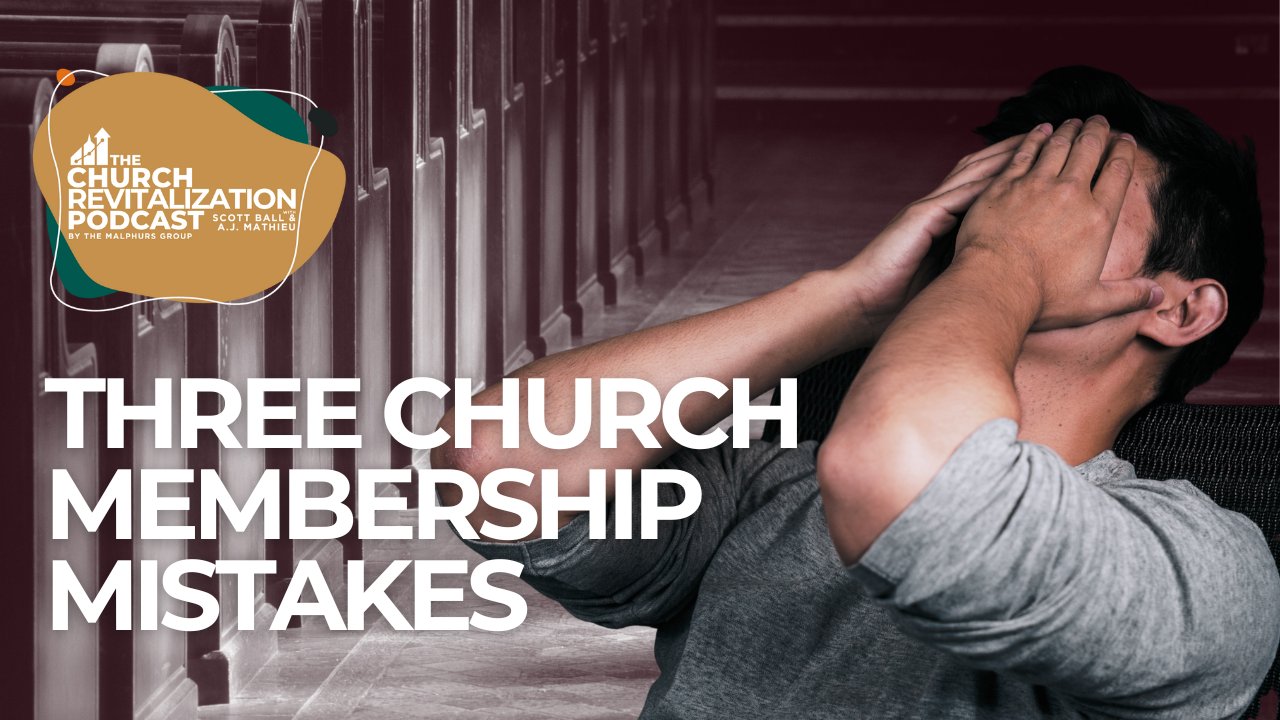The Church Revitalization Podcast – Episode 317– Church Membership Process
Many churches face the challenge of people attending regularly but not committing to membership. While it’s tempting to blame declining commitment in our culture, the real issue often lies with the church membership process itself.
If your church struggles to convert regular attenders into committed members, you might be making one of three critical mistakes. The good news? Each one has a straightforward fix.
Why Your Church Membership Process Matters
Before diving into the mistakes, it’s worth asking: why does a church membership process matter at all?
There is a Biblical basis. Hebrews 10:24-25 calls believers to regular gathering and mutual encouragement. Acts 2:42-47 describes the early church’s committed community life. Ephesians 4:11-16 outlines how the body of Christ grows together through every member doing their part.
Membership isn’t just about filling roster spots. It’s about creating a framework where people can live out the “one another” commands of Scripture. When someone commits to a local church, they’re saying, “This is my spiritual family, and I’m all in.”
A well-designed church membership process removes unnecessary barriers while maintaining the significance of commitment. It helps people understand what they’re joining, why it matters, and what comes next.
Mistake #1: Not Right-Sizing Your Church Membership Process
The Problem
Churches typically fall into one of two extremes when designing their membership process.
Some create an exhaustive process requiring lengthy meetings, multiple required events, paperwork, and complicated procedures. The burden becomes so heavy that interested people either drop out midway or never start at all.
Others swing to the opposite extreme with a “sign a card and you’re in” approach. There’s no meaningful conversation, no connection with leadership, and no real understanding of what membership means. This devalues membership entirely and creates a shallow church culture where commitment means nothing.
Both approaches fail, just in different ways.
The Fix
Your church membership process should be substantial enough to matter but streamlined enough to complete. Focus on four essential elements:
- Who we are as a church
- What we believe theologically
- Where we’re going as a congregation
- How you fit into the mission
Aim for a total of 2-4 hours of content. This could be one long session or 2-3 shorter meetings spread across a few weeks. The key is keeping the substance while cutting the fluff.
Replace that exhausting eight-week class with one compelling, well-designed experience. Make it engaging, personal, and memorable. People should leave understanding your church’s identity, excited about the mission, and ready to commit.
Mistake #2: Failing to Communicate a Clear “Why”
The Problem
Many churches assume people automatically understand the value of membership. They never articulate why someone should take this step or what benefits come with commitment.
Without a compelling “why,” potential members see membership as an outdated formality rather than a meaningful step. They wonder what’s in it for them, and when there’s no good answer, they simply don’t bother.
The Fix
Your church membership process must include a clear, compelling vision for why membership matters. This vision should be both biblical and practical.
The Biblical Foundation
Ground membership in Scripture. Show how the New Testament consistently pictures Christians as part of a committed local body, not isolated individuals. Reference passages like Hebrews 10:24-25, Acts 2:42-47, and Ephesians 4:11-16 to demonstrate that commitment to a local church isn’t optional in God’s design.
The Practical Benefits
Articulate specific benefits that come with membership:
Belonging: You become part of a spiritual family with deep, lasting relationships.
Voice: You gain input into the church’s direction and decision-making.
Care: The church commits to shepherd you, pray for you, and walk with you through life’s challenges.
Growth: You receive accountability and intentional discipleship to help you mature in faith.
Purpose: You gain a clear process to discover your gifts, serve meaningfully, and lead others.
Don’t save this information exclusively for your membership class. Mention it regularly from the pulpit, in new visitor materials, and in one-on-one conversations. Make the value of membership so clear that people want what you’re offering.
Mistake #3: Treating Membership as a Finish Line Instead of a Starting Line
The Problem
Too many churches treat membership as the end goal. There’s a big buildup, the person officially joins, and then… nothing. No follow-up, no ongoing care, no system for tracking engagement.
Members can disappear for months, and no one notices. There’s no process for checking in, ensuring connection to a small group, or helping people find their serving role. The church membership process dead-ends at the membership moment.
This “one and done” approach reveals a transactional mindset rather than a relational one. It reduces membership to a checkbox exercise instead of the beginning of a lifelong discipleship relationship.
The Fix
Design your church membership process so membership is clearly the starting line, not the finish line. What happens after someone joins matters just as much as what happens before.
The First 90 Days
Create a systematic check-in process for new members. Ensure each person connects to your primary discipleship ministry and identifies a serving role within their first three months. Assign someone specific to walk with them during this critical window.
Ongoing Care
Establish an annual “state of your membership” conversation or survey. Touch base with every member at least once per year to assess their spiritual health, address concerns, and celebrate growth. This doesn’t all need to fall on the senior pastor. Train elders, deacons, and lay leaders to shepherd specific members.
Re-engagement Process
Develop a clear process for when members become inactive. Rather than letting people drift away silently, reach out with genuine care. Ask what happened, listen well, and invite them back into active participation.
Tracking System
Implement a simple system to track member engagement. This isn’t about being controlling or judgmental. It’s about fulfilling your responsibility to care for souls entrusted to your leadership.
When someone submits to your church’s leadership by becoming a member, you take on the weighty responsibility of shepherding that person. As Hebrews 13:17 reminds us, leaders will give an account for those under their care. Take that seriously.
Making Your Church Membership Process Work: Three Implementation Keys
Fixing these mistakes requires more than just good intentions. Here are three practical steps to implement changes effectively.
1. Communicate Consistently
Don’t let your church membership process become an afterthought mentioned only when you notice new faces.
Talk about it from the pulpit with regularity. Train greeters, volunteers, and leaders to discuss membership naturally in conversations. Celebrate new members publicly and share their stories to inspire others.
Ensure your website, bulletin, and announcements all point clearly to the process. Remove every bit of confusion about “What do I do next?” Make the process so clear that any regular attender could explain it.
2. Track What Matters
You can’t improve what you don’t measure. Track key metrics like:
- What percentage of regular attenders become members?
- How long does the average person attend before joining?
- What percentage of members are engaged in serving?
- What percentage participate in small groups?
- What’s your member retention rate year over year?
Use this data to identify weak points in your process and make targeted improvements. If lots of people start the membership process but few finish, your process might be too complicated. If members join but quickly disengage, your post-membership discipleship needs work.
3. Start Small
Don’t try to overhaul everything at once. Choose one of these three mistakes and fix it in the next 30 days. Audit your current church membership process honestly, identify the most glaring issue, and make one significant improvement.
As that change takes root, move to the next area. Sustainable change happens incrementally, not all at once.
Your Next Step
A clear, balanced church membership process removes barriers while maintaining meaning. It honors both the biblical call to commitment and the practical realities of modern church life.
Membership matters because commitment matters. When people formally join your church, they’re making a covenant to grow, serve, and live out their faith in community. That’s significant.
But they can only make that commitment well if you’ve designed a process that makes sense.
Review your current process this week. Where are the bottlenecks? Does it confuse people or make commitment unnecessarily difficult? Where have you devalued membership by making it too easy?
Then take action. Fix one thing. Make one improvement. It doesn’t need to be perfect, but it does need to be intentional.
The goal isn’t just filling membership rolls. It’s helping people take meaningful steps toward spiritual maturity and deeper community. When your process works well, everyone wins.
Also check out:
When Is the Best Time for Volunteer Recruitment?
15 Reasons Why Committed Christians Do Not Attend Church
Three Most Common Revitalization Mistakes
Watch this episode on YouTube!


A.J. Mathieu is the President of the Malphurs Group. He is passionate about helping churches thrive and travels internationally to teach and train pastors to lead healthy disciple-making churches. A.J. lives in the Ft. Worth, Texas area, enjoys the outdoors, and loves spending time with his wife and two sons. Click here to email A.J.

